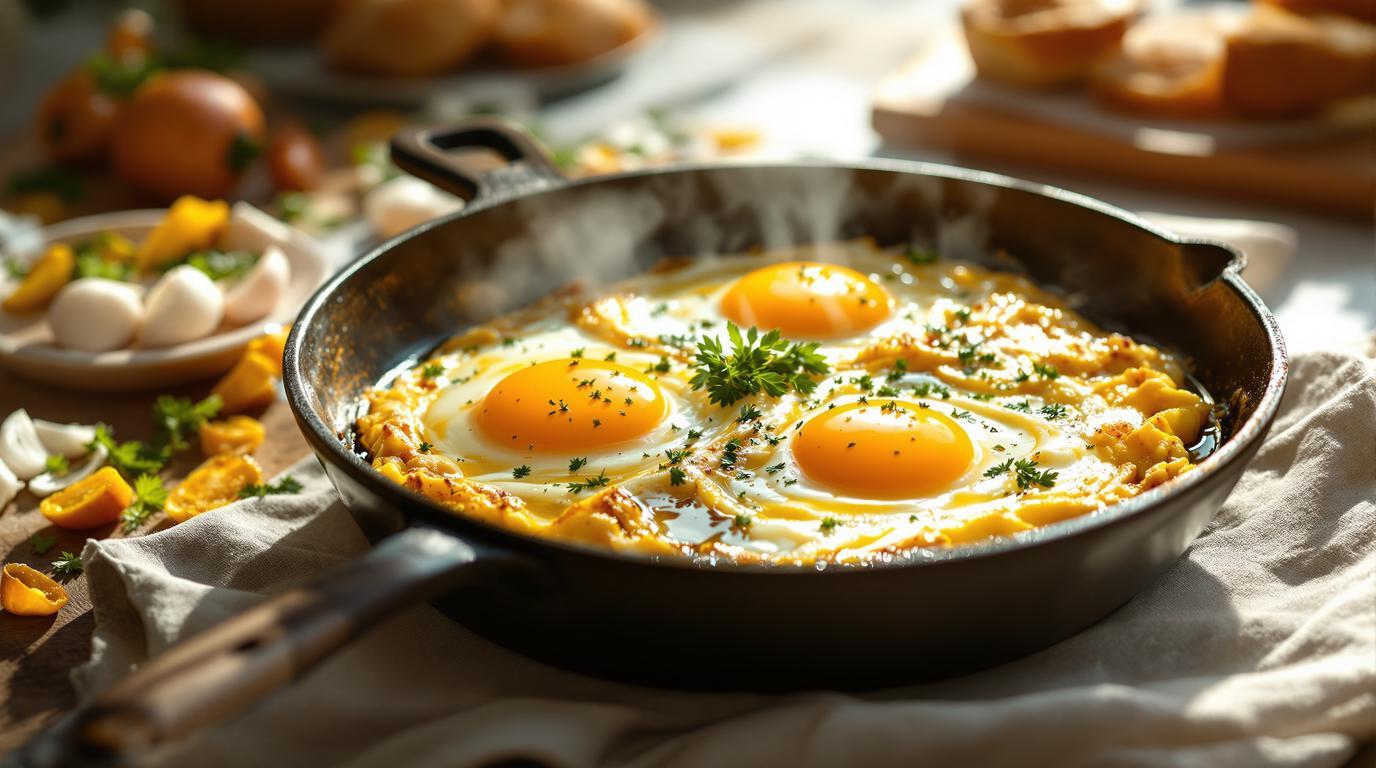There’s something almost magical about the way my grandmother transformed ordinary eggs into an extraordinary experience. Growing up in Trinidad, I’d watch her hands move with practiced precision, whisking eggs with such vigor you’d think she was conducting an orchestra. “The secret is in the wrist,” she’d tell me with a wink. This isn’t just any fried egg recipe—it’s a cherished tradition from the Caribbean that produces the fluffiest, most flavorful eggs you’ll ever taste, with a delicate crust that gives way to a tender interior. The high-heat cooking technique creates a textural contrast that will forever change how you approach this humble breakfast staple.
The Story Behind Trinidadian Whisked Eggs 📖
In Trinidad, where my culinary journey began, breakfast is never rushed. This egg preparation showcases the island’s talent for transforming simple ingredients into something extraordinary through technique rather than complexity. The aggressive whisking method—beating eggs 100 times with a fork—originated from necessity when electric mixers weren’t available, but produced such superior results that the tradition continues even when modern conveniences are at hand.
My grandmother explained that this recipe emerged from the melting pot of African, Indian, and European influences that define Trinidadian cuisine. The incorporation of hot peppers reflects the island’s love affair with bold flavors, while the meticulous whisking technique demonstrates the care taken with even the most everyday dishes.
Chef’s Note: The true magic of this recipe lies in contrast—crispy edges giving way to a pillowy interior. If your eggs aren’t developing that characteristic textural difference, your pan likely isn’t hot enough. You should hear an immediate sizzle when the eggs hit the oil.
Essential Ingredients 🧾
For 2 servings, you’ll need:
- 6 large eggs, as fresh as possible (room temperature works best)
- ½ small onion, sliced paper-thin (about ⅓ cup/50g)
- 2 cloves garlic, sliced (not minced—we want textural elements)
- 3 tablespoons (45ml) extra virgin olive oil
- 1 teaspoon (5g) Himalayan or kosher salt
- ¼ teaspoon (1g) freshly ground black pepper
- 1-2 habanero or scotch bonnet peppers, seeded and thinly sliced (adjust to your heat preference)
- Optional: 2 pimento peppers, finely chopped for color and fruity contrast
Can’t find habaneros? Serrano peppers make an excellent substitute, though they’ll provide a different heat profile. For a milder version that kids will enjoy, use just a pinch of red pepper flakes instead. I’ve seen some modern interpretations add a tablespoon of chopped fresh culantro (different from cilantro and common in Caribbean cooking), which adds a lovely herbal note.
Step-by-Step Instructions 📝
1. Crack eggs into a large bowl and add the thinly sliced onion, garlic, salt, pepper, and peppers.
2. Using a fork or whisk, beat the mixture vigorously for about two minutes—approximately 100 strokes. This isn’t an exaggeration! Count if you must. You’re looking for a frothy, light mixture where the whites and yolks are completely integrated. The aggressive whisking creates air pockets that make the eggs exceptionally light when cooked.
3. Heat a large cast-iron skillet or heavy-bottomed pan over high heat until it’s very hot, about 2 minutes. The pan should be so hot that when you hover your hand a few inches above it, you can feel significant heat radiating.
4. Add the olive oil and swirl to coat. The oil should shimmer immediately and be just short of smoking (approximately 375°F/190°C).
5. Pour the egg mixture into the hot oil. It should sizzle dramatically and immediately begin to bubble around the edges.
6. Cook undisturbed for about 2 minutes until the bottom develops a golden-brown crust while the top remains slightly wet.
7. Using a flexible spatula, carefully flip the eggs in sections (it doesn’t need to be one perfect flip) and cook for just 30 seconds more. The inside should remain tender and moist—we’re not aiming for completely set eggs here.
Chef’s Secret Techniques 🤫
The 100-stroke whisking method is non-negotiable. When I first started cooking professionally, I thought I could achieve the same results with a quick blend in a mixer. My grandmother promptly corrected this notion! The aggressive manual whisking creates a different texture than machine mixing.
Another critical element is the temperature cascade. Starting with oil that’s just short of smoking creates that signature crispy bottom, while removing the pan from heat shortly after flipping prevents the eggs from overcooking. The residual heat from the pan will gently finish the cooking process.
For the absolute best flavor, use a well-seasoned cast iron pan. The flavor memories (what professional chefs call “seasoning”) from previous cooking sessions add complexity that no non-stick pan can match. If you don’t have cast iron, carbon steel is the next best option.
Serving & Presentation Tips 🍽️
In Trinidad, we’d tear off pieces of homemade roti or flaky bake to scoop up the eggs. If you don’t have these on hand, toasted sourdough or a warm baguette makes an excellent substitute.
Serve immediately while the contrast between the crispy exterior and soft interior is at its peak. A side of fried plantains offers sweet balance to the savory eggs, while a fresh tomato salad dressed with lime juice cuts through the richness.
For a complete breakfast spread, consider pairing with my signature banana bread or fudgy brownies for a sweet counterpoint. If you’re feeling ambitious, deviled eggs make a wonderful companion for brunch service.
Every time I prepare this dish, I’m transported back to my grandmother’s kitchen in Trinidad, with morning sunlight streaming through open windows and the sounds of island life beginning outside. There’s something deeply comforting about carrying on this tradition, whisking eggs with the same rhythm and purpose that connected generations before me. I encourage you to approach this recipe not just as a set of instructions, but as an invitation to slow down and find joy in the simple perfection of eggs transformed through care and technique. Your kitchen may be far from Trinidad, but the heart of this dish—patience, precision, and love—translates to any home.
